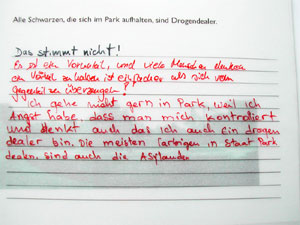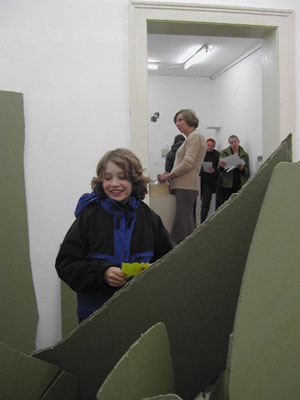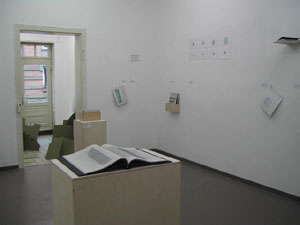(english)Seit 1991 realisiert Doris Koch Beteiligungsprojekte
im öffentlichen Raum. Ende der 1980iger Jahre wurden neue künstlerische
Strategien für die Kunst im öffentlichen Raum gefordert. Vor
diesem Hintergrund entwickelte sie ihre Form der partizipativen Kunstpraxis
und der Konzeptkunst. Charakteristisch für ihre Projekte ist: die
Verankerung im gesellschaftlichen Kontext und der Einbezug heterogener
Bevölkerungsgruppen. Ihr Interesse richtete sich in den letzten
Jahren auf die Entwicklung von Methoden der künstlerischen Recherche
und/oder von Prozessgestaltungen für Beteiligungsprojekte.
2002 bis 2003 hat Doris Koch in der Gemeinde Hohenstein das Modellprojekt
des Landes Baden-Württemberg "Kunst im Dorf - ein Kunstprojekt
im Kontext kommunaler Planung” konzipiert und kuratiert. Der Austausch
zwischen den Künstlern und der Bevölkerung hatte einen besonderen
Stellenwert. Es entwickelte sich ein dynamischer, lebendiger Prozess,
der bis heute nachhaltig wirkt. Seit 2003 entwickelte Doris Koch Konzeptionen
für mehrere Langzeitprojekte, eins davon In der Gemeinde Steinhöfel
/ Brandenburg, wo sie die Möglichkeiten und Anlage eines Beteiligungsprozesses
zwischen 12 Dörfern auslotet.
2005 wurde Doris Koch nach Dessau eingeladen, um im Stadtpark Dessau
eine künstlerische Recherche zu realisieren. Seit 1927 ist der
Stadtpark Dessau ein öffentlicher Park. Am Rande des Parks stellte
man 1970/1971 den Bau dreier Y-Hochhäuser fertig. Wegen ihrer innovativen
Bauweise und der attraktiven Lage waren die Wohnungen dort begehrt.
Nach 1989 wandelte sich das Gartenparadies langsam zu einem sozialen
Brennpunkt. Im Jahr 2000 wurde der Park zum Tatort. Der Mord von Rechtsradikalen
an einem Dessauer mocambiquanischer Herkunft schreckte nicht nur die
StadtbewohnerInnen auf. Er gilt heute als gefährlicher Ort, belagert
von Drogendealern. Obwohl mitten in der Stadt gelegen, wird der Park
von Vielen als Peripherie empfunden. Aufgrund leerer kommunaler Kassen
ist die Pflege des Parks auf notwendige Maßnahmen beschränkt.
Der Park ist in sozialer, politischer, stadtplanerischer und gesellschaftlicher
Hinsicht ein hochbrisanter Brennpunkt.
Anfang 2006 waren Ergebnisse ihrer Recherche im Stadtpark in der Bibliothek
und im Bürgerbüro in Dessau ausgestellt und fanden Anklang.
Bei einem Treffen, an dem 15 Akteure aus verschiedenen gesellschaftlichen
Bereichen teilnahmen, wurde einstimmig der Wunsch nach einer Projektentwicklung
geäußert. Anwesende der Stadtverwaltung nahmen dies auf und
erteilten den Auftrag.
So begann im August 2006 in Kooperation mit der URBAN II Geschäftsstelle
des Amtes für Stadtentwicklung der Stadt Dessau die Arbeit an der
Projektentwicklung "-Achtung- Quo vadis Stadtpark?". Doris
Koch formulierte drei konzeptionelle Ansätze. Auf dieser Grundlage
entwickelte sie im Dialog mit Akteuren vor Ort die weitere Prozessgestaltung.
Bis März 2007 sollte die Feinkonzeption in allen Facetten ausgearbeitet
sein, um dann in die Realisierung des Beteiligungsprojekts zu gehen.
Obwohl erfolgreich begonnen und seit August in der Öffentlichkeit
präsent, kam es nicht dazu. Die Bedingungen für die Realisierung
hatten sich so verändert, dass Doris Koch im Januar 2007 eine Realisierung
des Projekts für nicht machbar erklärte und schließlich
das Projekt im April 2007 beendet wurde. Grund war unter anderem die
Veränderung von Machtverhältnissen innerhalb der Verwaltung:
inzwischen hatten die Kooperationspartner des Projekts ihre Kompetenzbereiche
verloren und ein zweites Bürgerbeteiligungsprojekt mit einem grundverschiedenen
Ansatz, das zeitgleich stattfinden sollte, wurde forciert.
Im Rahmen der Ausstellung stellt Doris Koch mittels Zeichnungen, Fotos
und Texten das Projekt -Achtung- vor und reflektiert vor dem Hintergrund
des Geschehens offene Fragen, Strukturen, Eigenheiten von partizipativen
Projekten. In humorvoller und ironischer Weise bringt sie in Form einer
veränderbaren Installation die 65 Flächen des Parks in die
Räume der Oberwelt.
16. November bis 3. Dezember
2007
Since
1991, Doris Koch has been producing participatory projects in public spaces.
In 2006, the project “Achtung” (Watch out!) was developed
for the Stadtpark (city park) in Dessau in dialogue with the residents,
and cancelled in Spring 2007. In the context of the exhibition she will
reflect on this project, and continue it as a part of her work in progress
series “KunstMachen” (Art-Making) (actually it was supposed
to be something completely different…).
A project in collaboration with residents
in and for the Stadtpark Dessau
conception, as of August 2006
The Stadtpark
The Stadtpark Dessau has been a public park since 1927. Previously the
gardens of the Prince’s palace, it was redesigned as the “Stadtgarten”
(city garden).
By the end of the war in 1945 it had taken on the form of a potato patch
surrounded by ruins, with only isolated trees.
In the following years the park was reconstructed. Many people helped
in doing this. From the middle of the 1960’s it was extended to
the main post office.
In 1970/1971 three Y-form tower blocks were completed at the edge of the
park. Because of their innovative construction and attractive location
the flats there were in great demand.
For the aspiring large city of Dessau the Park was a flagship. Lying at
the centre of the industrial city the park was seen as an oasis of peace.
After 1989 the garden paradise transformed itself slowly into a social
combustion point. It was seen as a dangerous place besieged by drug dealers.
In 2000 the park became a crime scene. The murder of a Dessau man of Mozambique
extraction didn't only shock the city dwellers.
Although lying at the centre of the city, the park is experienced by many
as being on the periphery. Due to lack of communal funds, the care of
the park is limited to the bare necessities.
Working with enormous commitment, various groups have attempted to bring
positive life to the park, or tried, at least, to initiate debate about
it (e.g. playing Boules in the park, ParkTV project, Future Workshops).
As part of the programme of Urban II, the project “- Achtung Quo
Vadis - Stadtpark?” turns once again to the Stadtpark. The artist
and art theorist Doris Koch is responsible for the concept, coordination
and realisation.
The Conceptual Basis
The park consists of about 50 individual zones that are separated from
each other by pathways. There are smaller and larger zones, raised up
zones and zones in depressions.
There are zones where trees predominate and zones of predominantly grass.
Some are at the centre of attention and others disappear unobserved under
the shadow of the trees. Every zone is considered separately. The viewpoints
and categories taken into consideration have been previously introduced
and determined in a questionnaire about things in the park which you should
“watch out” for. Every criterion is uniformly applied to every
zone.
The consideration of individual zones allows a different way of looking.
A more playful and uninhibited interaction becomes possible.
The term “Achtung” (Watch out!) and its related verbs and
adjectives play a special role in every part in the project. For example,
the question wasn’t: What would you like to happen to the park?
But rather: What have you observed (“beobachten”) in the park?
What do you particularly value (“achten”) in the park? What
should we particularly look out for (“acht geben”) in the
park? The term “Achtung” is applied to the maintenance of
the park (aspect of caring), to the park as a meeting place (aspect of
consideration and respect for others) and to the park as an explosive
social space (aspect of awareness, reflection).
The actions of the “individual”, together with its consequences,
help to determine the nature of our environment, and are the starting
point for this project. Both the desirable and undesirable “consequences
of actions” found in the park are recorded. This also allows the
inclusion of absurd actions.
Due to its distance to reality, the artists’ way of working opens
up a space of possibility in which we can think differently and where
perceptions can be changed. Familiar questions are explored from the opposite
direction.
The Project
The Project - Achtung - achieves a inventory of the park using an artist’s
methodology. Many people should have the opportunity to participate in
the project on different levels. For this reason, the complete procedure
isn’t determined at the beginning. From August to October 2006 Doris
Koch will undertake further investigations and surveys. Following this,
the form of the process and of the organisation will become concrete.
The actual participatory process will take place in spring/summer 2007.
The process will be created out of a mix of various mechanisms and methods:
a publicly accessible info pool, with constantly updated information about
the process and content of the project, achieves transparency and allows
the later entry of interested parties into the already running project.
Site visits and workshops will certainly take place. Accompanying public
forums in the evenings can also encourage dialogue. There will be public
events at the start and end of the project, or to present intermediary
points. Interventions and actions in the park that originate from and
develop out of the findings are also possible.
In autumn 2007 the results will be collated and the, hopefully, dynamic
collaborative process documented. The process will be allocated the same
importance as the results. Concrete results build a pool of information
and an archive.
The creation of the information pool will already begin in 2006. A variety
of information about the park and its associated issues will be collected
and made publicly available in 2007.
The inventory will be initially saved in a digital archive and printed
onto file cards. The archive will be designed and set up in 2006, then
filled with the diversity of information in 2007.
The Objectives
The project should promote dialogue between different societal groups.
It should offer a space for encounters and debate on an equal footing.
Due to an approach that is shaped by the artists’ way of working,
new possibilities of creating a participatory process will be tested.
The concerns of people either using or engaging professionally with the
park should be taken up. It should be made possible for participants to
reflect on their familiar ways of looking at things and to be exposed
to other approaches. Urban spatial qualities like, e.g. the attributes
of the park zones, should be linked to social qualities like, e.g. recreational
behaviour. Aspects that would normally not be considered by a planning
inventory should play a part in this project.
The inventory of the various park zones and the options for their exploitation
should embrace both current and possible structures of usage and, in so
doing, make the potential of the park visible.
In order that the project can be effective over the long term, the archive
should be available for future protagonists, whether planners, committed
residents or artists, and so offer a basis for future planning, redevelopment,
actions or for artists’ projects.




